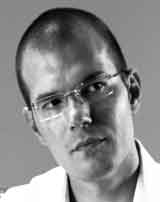 |
Domenico Quaranta is an art critic and independent curator based in Brescia, Italy, who has focused his research on the impact of the current techno-social developments on the arts. Along with Matteo Bittanti he is co-editor of GameScenes. Art in the Age of Videogames (Johan & Levi 2006) as well as the author of Media, New Media, Postmedia (Postmedia Books 2010) and In Your Computer (Lulu 2011). He has also curated various exhibitions, including “Holy Fire. Art of the Digital Age” (iMAL, Bruxelles 2008, with Y. Bernard), “Playlist” (LABoral, Gijon, 2009 and iMAL, Bruxelles, 2010); “Collect the WWWorld. The Artist as Archivist in the Internet Age” (Spazio Contemporanea, Brescia, 2011; House for Electronic Arts, Basel and 319 Scholes, New York, 2012). He is a regular contributor to Flash Art and a founding member of the Link Center for the Arts of the Information Age.
|